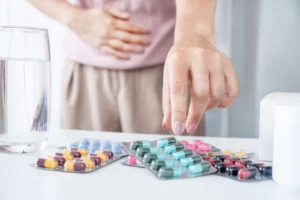The statistics around prescription drug addiction and dependence in the U.S. are staggering. Over 16 million Americans misuse prescription drugs each year, with nearly 4 million trying them for the first time.
Painkillers and sedatives are the most commonly abused, making up 43.3% and 32.1% of first-time misuse, respectively. Prescription drugs rank as the third most abused illegal substance, behind only marijuana and alcohol.
Because prescription drugs have such varying effects, the signs of addiction differ depending on the specific drug. Detoxing from prescription drugs without medical help can lead to dangerous health issues. With the right treatment and support, recovery is possible. But the first step is admitting there’s a problem and seeking help.

Commonly Misused Prescription Drugs
The most commonly misused prescription drugs fall into three categories: opioids, stimulants, and central nervous system (CNS) depressants.
Opioids
Doctors prescribe opioids like oxycodone (OxyContin) and hydrocodone (Vicodin) to relieve severe pain. Unfortunately, these narcotics are highly addictive and often abused. If you want to detox from opioids, talk to your doctor about slowly tapering the dosage under medical supervision.
Stimulants
Prescription stimulants such as Adderall and Ritalin are used to treat ADHD and narcolepsy. However, some people misuse them to stay awake or lose weight. Stopping stimulants abruptly can cause withdrawal symptoms like fatigue, depression, and suicidal thoughts.
CNS Depressants
Medications for anxiety, insomnia, and seizures like Xanax, Ambien, and Klonopin are CNS depressants that can be addictive if misused. Withdrawal from high doses or long-term use requires close monitoring as seizures and delirium are possible.
Symptoms of Prescription Drug Detox
The detox process from prescription drugs can be difficult and uncomfortable. The symptoms you experience depend on which medications you take and how long you are on them.
Opiate Withdrawal
If you are taking opiate painkillers like oxycodone or hydrocodone, you can expect withdrawal to start within 12 hours of your last dose. The most intense symptoms usually appear 3 to 5 days in, lasting 1 to 4 weeks in total. The common signs of opiate detox include:
- Low energy and fatigue
- Irritability, mood swings, and agitation
- Anxiety and difficulty sleeping
- Muscle aches, cramps, and pain
- Nausea, vomiting, diarrhea and stomach pain
- Sweating and chills
- Problems concentrating
Benzodiazepine Withdrawal
If you were taking anti-anxiety or sedative medications like Xanax or Valium, withdrawal can start within a few hours of your last dose. Acute withdrawal usually lasts 2 to 4 weeks, though some symptoms may persist for months. Common signs of benzo detox include:
- Anxiety, restlessness and irritability
- Insomnia and nightmares
- Muscle tension, pain and spasms
- Impaired memory and concentration
- Depression and suicidal thoughts
How Long Does Prescription Drug Detox Last?
The duration of prescription drug detox can vary depending on several factors unique to each person.
- Drug Type: The specific prescription drugs you were taking and their half-lives (how long it takes for the body to metabolize half the dose) directly impact how long detox will last. Drugs with shorter half-lives, like Xanax or Valium, typically require 3-5 days of detox.
- Amount and Time Used: Higher dosages over longer periods increase dependence and withdrawal severity. Someone on high doses of painkillers for years will likely experience more protracted detox than someone who briefly used anti-anxiety medication.
- Individual Factors: Age, weight, genetics, metabolic rate, and overall health status influence how your body processes drugs. Younger patients with faster metabolisms and no underlying conditions generally detox more quickly.

Common Prescription Drug Detox Programs
The detox process can be difficult, but there are programs tailored to help you safely stop taking certain prescription drugs.
Benzodiazepine Detox
For drugs like Xanax, Valium, and Ativan, a longer detox may be needed as they can take months to leave your system. Rehab centers provide medication and therapy to help ease withdrawal symptoms and reduce cravings. They also help establish coping strategies for anxiety and stress to avoid relapse.
Opiate Detox
If you depend on prescription opiates such as codeine, morphine, or oxycodone, opiate detox helps you stop taking them while managing withdrawal symptoms. Medications like buprenorphine or methadone are often used to reduce cravings and relieve symptoms like nausea or body aches. Opiate detox usually lasts around 7-14 days.
Stimulant Detox
For those dependent on stimulants like Ritalin, Adderall, or Dexedrine, detox helps safely stop use. It may involve medications for anxiety, depression, and sleep problems. Stimulant detox also focuses on developing new routines and coping skills to avoid relapse. The detox process typically lasts 3-7 days.
Sleeping Pill Detox
If you rely on prescription sleeping pills like Ambien, Lunesta, or Valium to sleep, detox helps you stop use under medical supervision. Medications and therapy help ease withdrawal symptoms and establish better sleep hygiene so you can sleep naturally again. Sleeping pill detox usually takes around 7-14 days.
A New Beginning: Reach Out To MD Home Detox
Recovering from prescription drug addiction and regaining health and independence is absolutely possible. At MD Home Detox, we provide the medical and emotional support to start a new chapter. We help build motivation and give encouragement for the personal recovery journey ahead.
If you or someone you know is struggling with prescription drug addiction, call an MD Home Detox center today at 1 (888) 592-7931. Help is available 24 hours a day, 7 days a week. A new beginning is just one phone call away.

